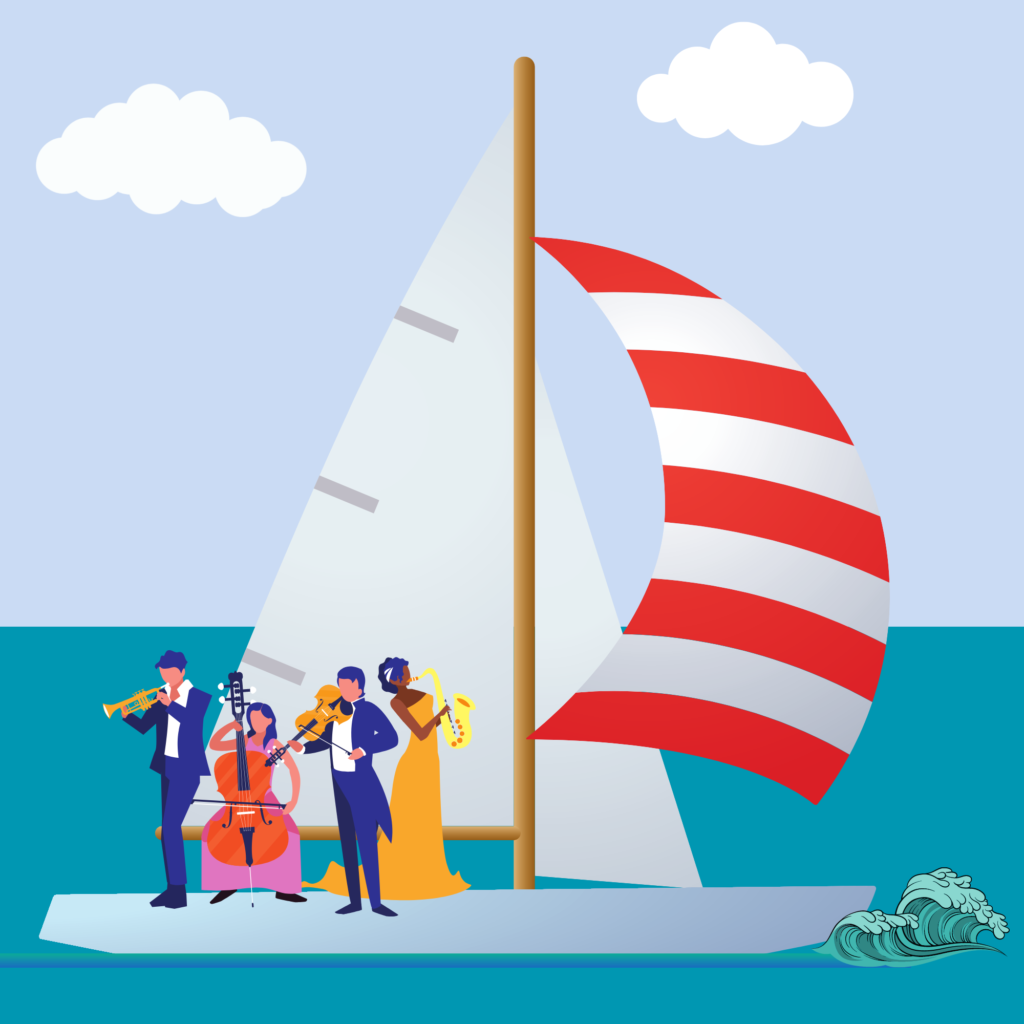Everything is connected to everything else,or at least so say the philosophers, polymaths, intellectuals, and mystics. As the world’s most famous polymath, or ‘renaissance man’, Leonardo Da Vinci, said “…Realize that everything connects to everything else.”
In other words, concepts that apply to one set of knowledge will often apply to another, seemingly disparate one. Complex systems, when broken down into smaller systems, reveal shared patterns and skills, even for fields as distant as sailing and music. It is this polymathic approach of integrating and synthesizing that spawns creativity and innovation.
Of all the passions or interests that one can have, the most fascinating connections are usually between those most disparate from each other. For some it may be engineering and ballet, medicine and skydiving, or bricklaying and politics (Winston Churchill).
Of my many interests that I pursue with passion, sailing stands out from the badges of music, writing, education, and creativity. It is a core belief of mine, however, that skills and sets of knowledge are inextricably linked. Finding the connections between music and sailing is part of my ongoing efforts to seek the connections between knowledge bases that we have isolated over hundreds of specialization and promote the holistic learning of all humanity. We should see the art in science and the science in art.
This is not an article of loose association between the worlds of sailing and music. There’ll be little reference to the soft yet upbeat music genre of yacht rock (check out Derrick Gee’s unique playlist). Rather, we’ll go deeper to explore the links between the systems and approaches of each. I do, however, wish I could delve into the highly impactful world of sea shanties.
Sailing itself is one of the most interdisciplinary and polymathic sports to be enjoyed. It requires an understanding of natural elements, a firm grasp on physics and mathematics, as well as the physical capacity to have a firm grasp on everything attached to the boat. For now, we’ll talk about the musicality of sailing, that is, the rhythm, group performance, and leadership.
Rhythm
Rhythm in music in a pattern in time. The length a note it held, the space in between instances, and their relation to a pulse and the other parts. In sailing it’s very much the same. There are instances that take place in time and, most important, in relation to the other parts at play, whether it be other people or the natural elements.
From the micro patterns patterns that occur in time, like the pull and easing of the boat as she heads of wind, to the regular synchronized rhythm of a crew in a tack or jibe, or the macro rhythm of the weather when planning a longer crossing – all are done as if synchronized to a universal music of nature, human and machine.
‘Threading the needle’
When at the helm (steering wheel) of a boat, particularly when going ‘upwind’, the resultant physical forces of the apparent wind against the sails, and the counterbalancing force of the keel and rudder, form a rhythm that sailors often call ‘threading the needle.” It’s the seemingly minute changes back and forth to keep the boat of course that imbue the threading of a needle.
The apparent wind running over the sails forms a low pressure zone on one side of the boat that tries to ‘suck’ it up into the wind which would result in no forward motion at all. The counterbalancing force of the keel works up until a point, but the added force of the rudder, under control by the sailor, steers it away from this ‘no go zone’ into the desired course for maximum speed. It’s a constant negotiation between the constant pulling of the natural elements and the helmsman’s desire to take the boat in a certain direction. To do this well, the sailor needs to have a good sense of the rhythm of the boat in the conditions; how often and how strongly she pulls to the wind, when to pull back and when to let her have her way.
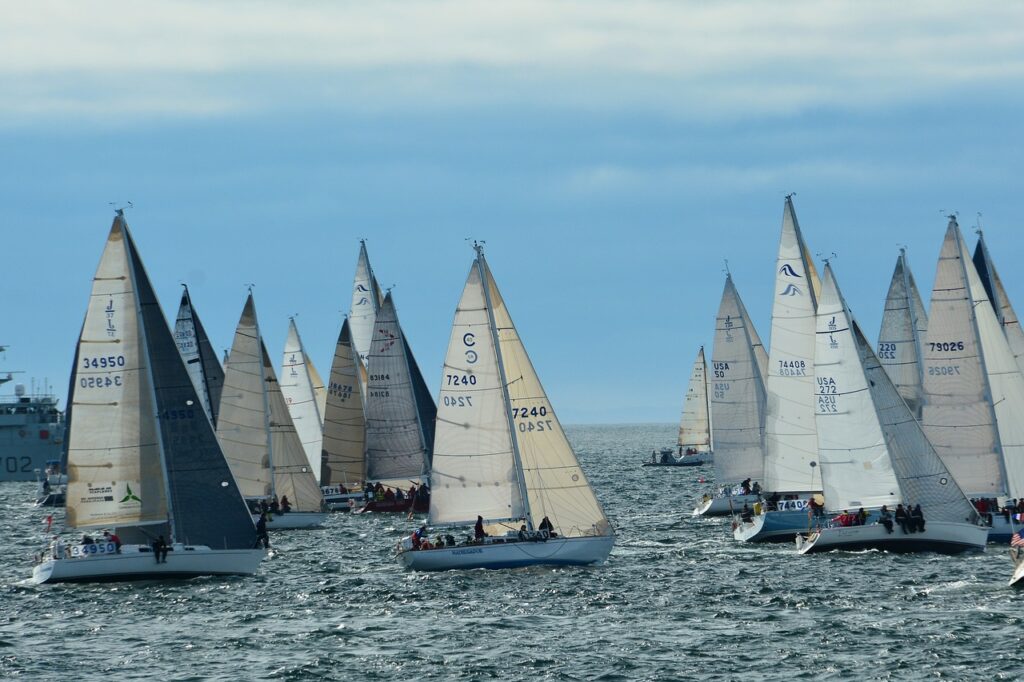
Group Performance and Timing
When playing in a musical ensemble, having good rhythm and timing is only as useful as your ability to listen to other musicians and the ensemble as a whole. You can have timing like clockwork but unless you can listen to your band members and negotiate the timing between yourselves, it’s going to fall to pieces. The same goes for the rhythm and timing of a sailing crew.
Tacking and Jibing
Doesn’t it just sound like a 1950’s dance sensation? Tacking and jibing doesn’t just have a boogaloo dance ring to it, the act itself is rhythmic and requires coordination with a partner.
Tacking and jibing are the most common maneuvers on a sailing boat and are very difficult to do single-handed. Like a rhythmically complex passage in a Stravinsky dance, they require the precise synchronization of all necessary crew members, particularly under race conditions.
In a tack, the boat changes its course to put the wind on the opposite side of the boat, necessitating a re-positioning of the sails. For the crew this means getting a feel for the rhythm of each other, the boat, and the conditions. After the helmsman (person on the wheel) calls the tack, the crew member on the jib sheet (rope connected to the front sail) for the current tack must time their release of the line (rope) with the conditions and movement of the boat, while the crew member on the other jib sheet side, must time their pulling-in of the line with that release, immediately followed by trimming (tightening). If the crew does not coordinate this with precise timing, the sail could flap out of control, causing a loss in speed, or the lines could get jammed or snared.
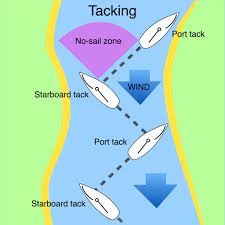
For the musician in me, a well-executed tack has a succinct triple meter, or 3/4-time feel: turn, release, pull/trim until taught. Depending on the conditions and the boat, the boom crossing to other side and filling with air adds an extra impulse to the group of three, some times making it a more interesting
A jibe, which can be more challenging, contains all the above but with the added hurdle of bringing the main sail across from its place on the far side of the boat to the far side in the other direction. This drastic change under strong air pressure requires a crew member to time the winding and release of the sail so that it doesn’t swing violently across of its own accord and damage equipment or, even worse, maim a crew member. Once again, the rhythmic placement extra instance depends on the boat and conditions, but often this adds an extra pulse at the end making a well-executed jibe a steady simple quadruple, or 4/4-time.
Of Conductors and Captains
For me, two of my most seemingly disparate passions, for which I am suitably qualified in each, are those of orchestral conducting and skippering a sailing yacht.
Connecting the personality traits and approaches of leaders across different fields doesn’t come as a great surprise; all leaders make decisions, inspire, teach and organize, but the approaches of conductor and sailing skipper (captain) are strikingly similar. The reason for this can be seen in the timing-orientated teamwork and performance-based nature of both sailing crews and orchestras.
When I tell people that I received a Masters degree in orchestral conducting they are a little incredulous. “You can get a masters degree in waving your arms around to music?” Is perhaps the most irritating reaction. Naturally, this completely ignorant reaction ignores the fact that conductors lead the music (not follow), the technical difficulties in synchronizing the massive musical machine that is an orchestra and, more importantly the aspects of preparing an orchestra, or which ‘waving one’s arms about’ are but a minor factor. Rather, musical leadership and pedagogy (the science of learning) are of integral importance. In a similar way, leadership and the ability to instruct are of great importance on board a sailing vessel, whether on a coastal cruise, inshore race, or on the open ocean.
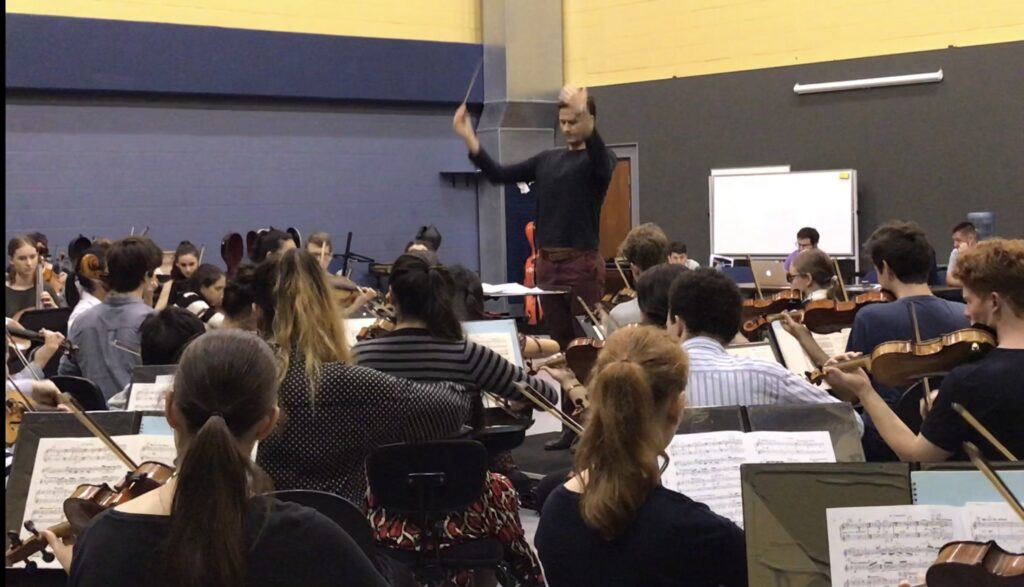
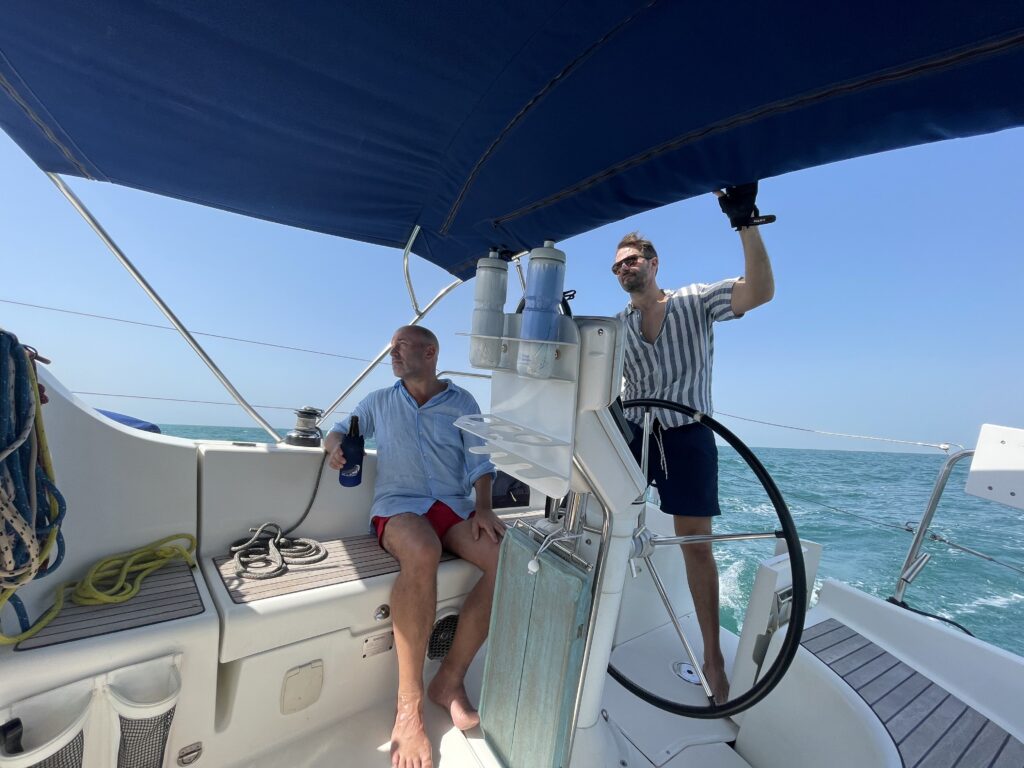
Cues
One of the first things you learn in the journey to becoming a conductor is how to cue, and it goes something like this:
1) Make decisive eye-contact and hopefully you get the same return, and not a wide-eyed panic that says “oh no I’m lost!”
2) Breathe in as you pull back your left hand with your thumb and index finger together as if to throw a dart, then;
3) throw and release and hope that it rouses them to enter on time or at least feel the sting of your disapproving glare.
Cues given by a skipper on a boat may not be so graceful, but the idea of preparation and execution are remarkably similar.
In earlier paragraphs we went through the rhythmic dance of tacking and jibing and its pattern of simple triple and simple quadruple time. Just as in an orchestra, these movements are directed by the leader and display a similar amount of focus and energy, particularly under race conditions.
A few moments before a tack or jibe the skipper will call it. “Ready to go-about?!” or similar is the usual, depending where you’re from. This is eye contact a few beats beforehand. The crew ensures everything is in place before returning with a loud and clear, “Ready!” – this is the returned eye contact.
Once the skipper hears this and is satisfied that the boat is ready to be hurled in another direction, they’ll call again, “Going about!” or “Tacking!”. This is the left hand being raised with the imaginary dart to throw at the musician/s about to enter. Then, with a decisive tug on the helm, the whole crew feels the boat move on the downbeat of the maneuver – this is the throw, the cue, and from here it’s more or less up to the performers to enter at the right time and execute their passage correctly.
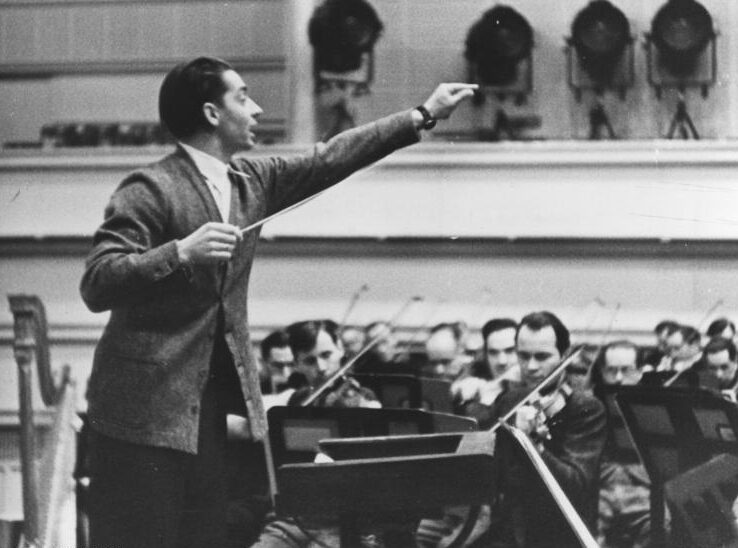
Ahead of the Beat/Boat
If you’ve seen a good orchestra perform you may have noticed that the conductor, for much of the time, tends to be conducting ahead of the beat. Once you notice this it can be slightly off-putting to see the arms mark the beat noticeably sooner than the orchestra plays it. It’s not a symptom of an incompetent conductor nor lazy orchestra musicians, it’s simply what works best. By this point you shouldn’t be surprised that it also works best in some sailing scenarios.
For one thing, the role of a conductor is to demonstrate and prepare the orchestra for what’s coming, not what’s happening at the precise moment. As a conductor, if you’re trying to convey the articulation or emotion of an instance at the precise time it’s happening, you’re already too late. The musicians need to know what’s coming slightly ahead of time.
Adding to this, the nature of the beast that is a 50-70 piece orchestra is that anything a conductor does will be slightly delayed because of human processing and the time it takes sound to travel.
For a skipper or helmsmans of a sailing yacht, there is also a delay to their direction or commands, but it’s not just the obvious delays caused by the chain of the crew’s reactions. Naturally, a skipper must take into account that, if they want to turn through the wind (tack) they can’t just do it immediately, the crew needs to be prepared. But on a more detailed level, even the movement of a boat as a result of turns of the wheel are delayed, particularly on the larger yachts.
This is because it takes water passing over the rudder to make the turn happen and, when turning a yacht they may weigh 10+tonnes, a lot of water needs to pass over the keel to make this happen. In this way, the ‘threading the needle’ task mentioned earlier becomes an even more challenging musical exercise. Not only does the helmsman have to get a feel for the rhythmic ebb and flow of the boat, they need to pre-empt these in the same way a conductor preempts the coming musicality of the piece being performed. It’s a cognitively demanding task, to be thinking in terms of the future, the present, and reflecting on the past, all simultaneously.
Tacet and Turning Torpor
The orchestral musicians reading this will know of another common pitfall that each of them has experienced at least once. It goes something like this: the conductor has been doing some isolated practice with different sections, you lost count of your 36 ars of tacet (rests) and you’re utterly lost, in dream land, or both. All of a sudden the conductor calls to your instrument group, “let’s hear the trombones…” and you’ve got nothing. You don’t know whether it’s bar 16 or 316, or whether the orchestra has changed pieces completely. You feel like an absolute amateur but in this situation it’s not entirely your fault.
The conductor should have ensured you had the chance to play regularly, or at least given you an active task to stay with the group i.e. following along your part here, or listen to this part that you’ll be playing with etc. A good conductor knows that to keep you in peak performance or rehearsal mode, they need to keep you engaged. A sailing skipper knows the same.
On a sailboat it’s easy to get distracted by the beauty around you or grow complacent in such a serene environment. The nature of the ocean, weather, and human interaction however is greatly unpredictable, and the sudden necessity for all hands on deck can arise at any time have heavy consequences.
Even in some coastal racing scenarios, if the boat is staying on the same point of sail for an extended period of time, depending on the number of crew, there will likely be some who will be sitting around enjoying the view of the distant coastline or growing torpor in the midday sun. Without warning the boat ahead tacks (changes direction and side to the wind) without checking and the boat needs to take evasive actions. The skipper barks orders but the two crew members he needs are off in dream land. A good skipper, like a good conductor, will make sure each crew member is engaged at least enough to be aware of their surroundings. “Keep a lookout on that side for me” (the helmsman or skipper won’t be able to see on one side of the sail), or “ tidy these ropes,” or “can you spot the next marker?” Are tasks that are easy and keep the sailor engaged with the task at hand. “Go down below and get me a beer,” is also another useful one.
Coda/Beers at the Clubhouse
There are several more approaches of a conductor that are reflected in the role of a skipper of a sailing yacht. Some connections are a little more abstract, some reflect general organizational or leadership skills, but some are uncanny. From my experience in both of these seemingly disparate worlds. One thing is remarkably similar. Musicians and sailors reflect on performances/rehearsals with their performances in a similar way, whether it be formally in rehearsal, or over a drink at the bar/clubhouse
We can wax lyrical (I quite often do) about the poetic connection of the transformative and cathartic experience of both music and sailing. Gliding through crystalline sea with no sound but the wind and water eliciting their necessary forces can imbue the same serenity or, conversely, excitement, as listening to a piece of music you love and being transported to an introspective world.
Perhaps much of the reason behind this ‘felt’ connection comes down to not simply the associated emotions but something deeper and even tangible. The phenomena has their genesis in tangible connections, a route through various disciplines, but a shared meeting point in the affections they stir in us humans.

